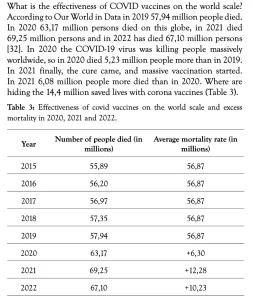An article in the Lancet claims that 20 million lives were saved with the use of COVID ‘vaccines’. Where is the evidence for this? How sound is it? Where is the risk benefit analysis? How many lives saved compared to how many excess deaths caused or at least strongly associated with the COVID injections worldwide?
Here is the article:
23 June, 2022 – Global impact of the first year of COVID-19 vaccination: a mathematical modelling study
Findings: Based on official reported COVID-19 deaths, we estimated that vaccinations prevented 14·4 million (95% credible interval [Crl] 13·7-15·9) deaths from COVID-19 in 185 countries and territories between Dec 8, 2020, and Dec 8, 2021. This estimate rose to 19·8 million (95% Crl 19·1-20·4) deaths from COVID-19 averted when we used excess deaths as an estimate of the true extent of the pandemic, representing a global reduction of 63% in total deaths (19·8 million of 31·4 million) during the first year of COVID-19 vaccination.
24 June, 2022 – COVID vaccines saved 20M lives in 1st year, scientists say,
According to a study published Thursday. June 23, 2022 in the journal Lancet Infectious Diseases, nearly 20 million lives were saved by COVID-19 vaccines during their first year, but even more deaths could have been prevented if global targets had been reached. (Pfizer via AP)
A bright red flag is here:
“This work was supported by a Schmidt Science Fellowship in partnership with the Rhodes Trust (OJW), Centre funding from the UK Medical Research Council (all authors), grant funding from WHO (OJW, ABH, PW, and ACG), Gavi, The Vaccine Alliance, and the Bill & Melinda Gates Foundation (JT and ACG), support from the Imperial College Research Fellowship (PW and ABH), and support from the National Institute for Health Research Health Protection Research Unit in Modelling Methodology and Community Jameel (all authors). We thank Sondre Ulvund Solstad from The Economist for developing excess mortality statistics and their help in interpreting these estimates.”
There are clear conflicts of interest in the funding from bodies directly invested in the vaccine industry such as Bill and Melinda Gates Foundation and GAVI.
Imperial College London are the original modellers that grossly over-estimated the expected GOVID deaths leading to policies and practices based on unrealistic fear. They predicted over half a million deaths in the UK and over 2 million deaths in the US. They had a vested interest in balancing the books with a model that produced an outcome with strikingly similar number of ‘lives saved’.
WHO (World Health Organisation) are funded heavily by the Gates Foundation. They are at present lobbying to have global oversight over all future pandemics. Changes to the IHR (International Health Regulations, if successful will give them unprecedented powers including mandating vaccination in all member countries.
24 June, 2022 – Did Covid Vaccines Save Tens of Millions of Lives?
A recent preprint, with the now questionable Medical Journal Lancet, makes the claim that the Covid vaccine introduction in December 2020 actually prevented tens of millions of deaths worldwide.
This paper was submitted by the research group headed by Azra Ghani from the Imperial College of London. Dr. Ghani acts as a consultant for HSBC, GlaxoSmithKline, and the WHO and as with her other Imperial College colleagues, has been pro-lockdown/pro-panic, and pro-vaccine for more than two years.
20 August, 2022 – 20 million saved or 20 million killed
A single logical fallacy destroys the claims in the piece published on the Lancet. Brownstone (Roger Koops) describes it like this:
“C. Population Susceptibility
The above piece completely ignores the huge gradient in mortality susceptibility in the population. Younger people have had very low infection mortality throughout the past two years. The mathematical models assume the same level of mortality susceptibility across all populations. This assumption we know to be a fallacy and completely negates any of their “models.”
“The mathematical models that have been presented from Imperial College have always been wildly WRONG.”
In other words, the Lancet piece assumes that the young have the same remaining life as the elderly. Ludicrous.
analysis-of-covid19-vaccination-effectiveness 




Writes Oz’s Substack
Aug 10: